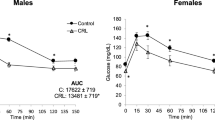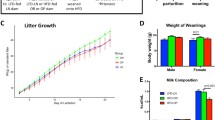Abstract
Maternal health and diet can have important consequences for offspring nutrition and metabolic health. During lactation, signals are communicated from the mother to the infant through milk via macronutrients, hormones, and bioactive molecules. In this study we designed experiments to probe the mother-milk-infant triad in the condition of normal maternal health and upon exposure to high fat diet (HFD) with or without concurrent metformin exposure. We examined maternal characteristics, milk composition and offspring metabolic parameters on postnatal day 16, prior to offspring weaning. We found that lactational HFD increased maternal adipose tissue weight, mammary gland adipocyte size, and altered milk lipid composition causing a higher amount of omega-6 (n6) long chain fatty acids and lower omega-3 (n3). Offspring of HFD dams were heavier with more body fat during suckling. Metformin (Met) exposure decreased maternal blood glucose and several milk amino acids. Offspring of met dams were smaller during suckling. Gene expression in the lactating mammary glands was impacted to a greater extent by metformin than HFD, but both metformin and HFD altered genes related to muscle contraction, indicating that these genes may be more susceptible to lactational stressors. Our study demonstrates the impact of common maternal exposures during lactation on milk composition, mammary gland function and offspring growth with metformin having little capacity to rescue the offspring from the effects of a maternal HFD during lactation.








Similar content being viewed by others
Availability of Data and Material
RNA seq data is available and has been linked to this manuscript.
Change history
31 October 2023
Updated the name tagging of the 3rd author as follows given name is "Noura" and last name is "El Habbal".
References
Bartol FF, Wiley AA, Bagnell CA. Epigenetic programming of porcine endometrial function and the lactocrine hypothesis. Reprod Domest Anim. 2008;43(Suppl 2):273–9. https://doi.org/10.1111/j.1439-0531.2008.01174.x.
Bode L, et al. Understanding the mother-breastmilk-infant “triad.” Science. 2020;367(6482):1070–2. https://doi.org/10.1126/science.aaw6147.
Ellsworth L, et al. Lactational programming of glucose homeostasis: a window of opportunity. Reproduction. 2018;156(2):R23–42. https://doi.org/10.1530/REP-17-0780.
Hafner H, et al. Lactational High-Fat Diet Exposure Programs Metabolic Inflammation and Bone Marrow Adiposity in Male Offspring. Nutrients. 2019;11(6). https://doi.org/10.3390/nu11061393.
Liang X, et al. Maternal high-fat diet during lactation impairs thermogenic function of brown adipose tissue in offspring mice. Sci Rep. 2016;6:34345. https://doi.org/10.1038/srep34345.
Masuyama H, Hiramatsu Y. Additive effects of maternal high fat diet during lactation on mouse offspring. PLoS ONE. 2014;9(3): e92805. https://doi.org/10.1371/journal.pone.0092805.
Carlson Z, et al. Lactational metformin exposure programs offspring white adipose tissue glucose homeostasis and resilience to metabolic stress in a sex-dependent manner. Am J Physiol Endocrinol Metab. 2020;318(5):E600–12. https://doi.org/10.1152/ajpendo.00473.2019.
Dos Santos CO, et al. An epigenetic memory of pregnancy in the mouse mammary gland. Cell Rep. 2015;11(7):1102–9. https://doi.org/10.1016/j.celre2015.04.015.
Ellsworth L, et al. Impact of maternal overweight and obesity on milk composition and infant growth. Matern Child Nutr. 2020;16(3): e12979. https://doi.org/10.1111/mcn.12979.
Kuhn NJ, Lowenstein JM. Lactogenesis in the rat. Changes in metabolic parameters at parturition. Biochem J. 1967;105(3):995–1002. https://doi.org/10.1042/bj1050995.
Arthur G, Smith M, Hartmann E. Milk lactose, citrate, and glucose as markers of lactogenesis in normal and diabetic women. J Pediatr Gastroenterol Nutr. 1989;9(4):488–96. https://doi.org/10.1097/00005176-198911000-00016.
Harvey I, et al. Glucocorticoid-Induced Metabolic Disturbances Are Exacerbated in Obese Male Mice. Endocrinology. 2018;159(6):2275–87. https://doi.org/10.1210/en.2018-00147.
Parlee SD, et al. Quantifying size and number of adipocytes in adipose tissue. Methods Enzymol. 2014;537:93–122. https://doi.org/10.1016/B978-0-12-411619-1.00006-9.
Patro R, et al. Salmon provides fast and bias-aware quantification of transcript expression. Nat Methods. 2017;14(4):417–9. https://doi.org/10.1038/nmeth.4197.
Love MI, et al. Tximeta: Reference sequence checksums for provenance identification in RNA-seq. PLoS Comput Biol. 2020;16(2): e1007664. https://doi.org/10.1371/journal.pcbi.1007664.
Soneson C, Love MI, Robinson MD. Differential analyses for RNA-seq: transcript-level estimates improve gene-level inferences. F1000Res. 2015;4:1521. https://doi.org/10.12688/f1000research.7563.2.
Love MI, Huber W, Anders S. Moderated estimation of fold change and dispersion for RNA-seq data with DESeq2. Genome Biol. 2014;15(12):550. https://doi.org/10.1186/s13059-014-0550-8.
Subramanian A, et al. Gene set enrichment analysis: a knowledge-based approach for interpreting genome-wide expression profiles. Proc Natl Acad Sci U S A. 2005;102(43):15545–50. https://doi.org/10.1073/pnas.0506580102.
Mootha VK, et al. PGC-1alpha-responsive genes involved in oxidative phosphorylation are coordinately downregulated in human diabetes. Nat Genet. 2003;34(3):267–73. https://doi.org/10.1038/ng1180.
R: The R Project for Statistical Computing. Available from: www.r-project.org.
Newburg DS, Woo JG, Morrow AL. Characteristics and potential functions of human milk adiponectin. J Pediatr. 2010;156(2 Suppl):S41–6. https://doi.org/10.1016/j.jpeds.2009.11.020.
Yamauchi T, et al. The fat-derived hormone adiponectin reverses insulin resistance associated with both lipoatrophy and obesity. Nat Med. 2001;7(8):941–6. https://doi.org/10.1038/90984.
Hernandez LL, et al. High fat diet alters lactation outcomes: possible involvement of inflammatory and serotonergic pathways. PLoS ONE. 2012;7(3): e32598. https://doi.org/10.1371/journal.pone.0032598.
Silverman J, Stone DW, Powers JD. The lipid composition of milk from mice fed high or low fat diets. Lab Anim. 1992;26(2):127–31. https://doi.org/10.1258/002367792780745832.
Monks J, et al. Maternal obesity during lactation may protect offspring from high fat diet-induced metabolic dysfunction. Nutr Diabetes. 2018;8(1):18. https://doi.org/10.1038/s41387-018-0027-z.
Ramos P, Martin-Hidalgo A, Herrera E. Insulin-induced up-regulation of lipoprotein lipase messenger ribonucleic acid and activity in mammary gland. Endocrinology. 1999;140(3):1089–93. https://doi.org/10.1210/endo.140.3.6565.
Patterson E, et al. Health implications of high dietary omega-6 polyunsaturated Fatty acids. J Nutr Metab. 2012;2012:539426. https://doi.org/10.1155/2012/539426.
Scorletti E, Byrne CD. Omega-3 fatty acids, hepatic lipid metabolism, and nonalcoholic fatty liver disease. Annu Rev Nutr. 2013;33:231–48. https://doi.org/10.1146/annurev-nutr-071812-161230.
Mohammad MA, Sunehag AL, Haymond MW. Effect of dietary macronutrient composition under moderate hypocaloric intake on maternal adaptation during lactation. Am J Clin Nutr. 2009;89(6):1821–7. https://doi.org/10.3945/ajcn.2008.26877.
Nasser R, et al. The effect of a controlled manipulation of maternal dietary fat intake on medium and long chain fatty acids in human breast milk in Saskatoon, Canada. Int Breastfeed J. 2010;5: 3. https://doi.org/10.1186/1746-4358-5-3.
Jonsson K, et al. Fat intake and breast milk fatty acid composition in farming and nonfarming women and allergy development in the offspring. Pediatr Res. 2016;79(1–1):114–23. https://doi.org/10.1038/pr.2015.187.
Koletzko B, et al. Infant feeding and later obesity risk. Adv Exp Med Biol. 2009;646:15–29. https://doi.org/10.1007/978-1-4020-9173-5_2.
Casper D, Schingoethe DJ. Model to describe and alleviate milk protein depression in early lactation dairy cows fed a high fat diet. J Dairy Sci. 1989;72(12):3327–35. https://doi.org/10.3168/jds.S0022-0302(89)79494-7.
Beauchamp GK, Mennella JA. Flavor perception in human infants: development and functional significance. Digestion. 2011;83(Suppl 1):1–6. https://doi.org/10.1159/000323397.
Davis TA, et al. Amino acid composition of human milk is not unique. J Nutr. 1994;124(7):1126–32. https://doi.org/10.1093/jn/124.7.1126.
Ventura AK, Beauchamp GK, Mennella JA. Infant regulation of intake: the effect of free glutamate content in infant formulas. Am J Clin Nutr. 2012;95(4):875–81. https://doi.org/10.3945/ajcn.111.024919.
Tomlinson C, et al. Arginine is synthesized from proline, not glutamate, in enterally fed human preterm neonates. Pediatr Res. 2011;69(1):46–50. https://doi.org/10.1203/PDR.0b013e3181fc6ab7.
Shulman RJ. Effect of enteral administration of insulin on intestinal development and feeding tolerance in preterm infants: a pilot study. Arch Dis Child Fetal Neonatal Ed. 2002;86(2):F131–3. https://doi.org/10.1136/fn.86.2.f131.
Shehadeh N, Sukhotnik I, Shamir R. Gastrointestinal tract as a target organ for orally administered insulin. J Pediatr Gastroenterol Nutr. 2006;43(3):276–81. https://doi.org/10.1097/01.mpg.0000226377.03247.fb.
Thomas I, Gregg B. Metformin; a review of its history and future: from lilac to longevity. Pediatr Diabetes. 2017;18(1):10–6. https://doi.org/10.1111/pedi.12473.
Polianskyte-Prause Z, et al. Metformin increases glucose uptake and acts renoprotectively by reducing SHIP2 activity. FASEB J. 2019;33(2):2858–69. https://doi.org/10.1096/fj.201800529RR.
Funding
BG is supported by K08 DK102526, R56 DK121787, and the Amendt-Heller Award for Newborn Research. DB is supported by R01 DK107535. Amino acid and long-chain fatty acid levels were analyzed at the Michigan Regional Comprehensive Metabolomics Resource Core (MRC2) supported by grant DK097153 to the University of Michigan. We would also like to acknowledge the White Adipose Tissue Core, which is a part of the Michigan Nutrition and Obesity Center (P30 DK089503) for instruction in adipocyte size analysis. Body composition measurements were done with the assistance of the Mouse Metabolic Phenotyping Center (U2CDK110768). Histology was performed by the Rogel Cancer Center Histology Core (P30 CA04659229). RNA Sequencing was performed by the University of Michigan Advanced Genomics Core. ZC was funded by an internship through the Momentum Center of the University of Michigan.
Author information
Authors and Affiliations
Contributions
BG was responsible for the study design and conceived the original idea. ZC, BG, HH, NEH, EH, SL, NB, MA, CR, and HR carried out the experiments. ZC, HH, NB, BG, NEH and DB performed data analysis. Manuscript preparation was done by HH, BG, ZC, NEH, and DB. Manuscript editing was completed by ZC, EH, SL, NB, MA, CR, and HR. Input and approval on the final manuscript was provided by all authors.
Corresponding author
Ethics declarations
Conflict of interest
The authors declare no conflicts of interest with the work presented in this manuscript.
Additional information
Publisher's Note
Springer Nature remains neutral with regard to jurisdictional claims in published maps and institutional affiliations.
Supplementary Information
Below is the link to the electronic supplementary material.
Rights and permissions
Springer Nature or its licensor (e.g. a society or other partner) holds exclusive rights to this article under a publishing agreement with the author(s) or other rightsholder(s); author self-archiving of the accepted manuscript version of this article is solely governed by the terms of such publishing agreement and applicable law.
About this article
Cite this article
Carlson, Z., Hafner, H., El Habbal, N. et al. Short Term Changes in Dietary Fat Content and Metformin Treatment During Lactation Impact Milk Composition and Mammary Gland Morphology. J Mammary Gland Biol Neoplasia 27, 1–18 (2022). https://doi.org/10.1007/s10911-022-09512-y
Received:
Accepted:
Published:
Issue Date:
DOI: https://doi.org/10.1007/s10911-022-09512-y




